In trying to reclaim our spirituality, we Pagans can draw upon a vast range of sacred stories – usually termed ‘myths’ – about the deities we worship. This material is complex, fragmentary, and often contradictory and confusing. For those of us living in, or interested in, the land of Cymru (aka ‘Wales’) the task is more difficult. Nearly all of what we have is collected in the stories known as ‘Mabinogi(on)’, but nowhere are the characters in these stories considered as deities – rather they are wholly mortal – kings, queens, their families and hangers-on, a somewhat disfunctional bunch. Best known of the Mabinogi are the connected set of tales known as the ‘four branches’.
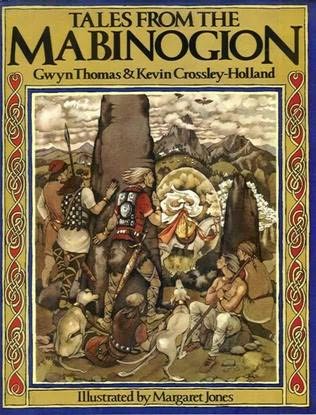
In ancient Greece, the philosopher Euhemerus did not ‘believe’ in deities – he claimed that the idea of such was a mis-remembering of ancient royalty and heroes (‘bad history’ we might say). Euhemerism has been a popular view of Pagan religion, taken by academics, Abrahamists, and even some modern Pagans. The first reteller of Norse myth, Snorri Sturluson, took a similar view in his ‘Ynglinga Saga’. Here in Cymru the opposite sort of process (without a fancy name) seems to have taken place. The Grimms and others suggested a form of derivation from myth with respect to ‘fairy tales’ – their view has been challenged. It is pretty universally accepted that the Mabinogi characters are deities, or ‘reflexes’ thereof, because of their close similarity to Irish myth (Don => Danu, Gofannon => Goibniu, Lleu => Lugh and so on). It remains very difficult to make any real sense of the stories, nor, apart from names, is there much correspondence with Irish material. Everyone seems to accept that the stories, as we have them, are ‘distorted’, yet at the same time, all seem also to accept a basic integrity in the plot lines.
I first found the Mabinogi nearly 50 years ago, initially via Evangeline Walton’s four novel-length retellings rather than the ‘proper’ text. (I can laugh now at how I pronounced “Pwyll” back then!) At least five translations are available into modern English, plus bowdlerisations, though how anyone can think the stories ‘suitable for kiddies’ I cannot comprehend. Academic discussion is aplenty, but seems confined to minutiae, and serious consideration of ancient Welsh religion is quite out of bounds. For these folk, the deities do not actually exist, so that the stories are studied only as things in themselves, unrooted, except perhaps as ‘perennial human drama’. The best-known Pagan commentary is by Caitlin Matthews in her ‘Mabon and the Mysteries of Britain’, which focuses on the Goddess of Sovereignty, (the) Madron, and Her Son, (the) Mabon. Matthews’ work is highly-regarded amongst Pagans, but rarely cited by academics.
The Theosophist Kenneth Morris wrote a development of the first branch in his work ‘The Fates of the Princes of Dyfed’ – he may be unique in trying to to reclaim the Deities and mythic mode. Walton’s novels have more ‘psychology’, focusing on a clash between ‘matrilinear’ and ‘patrilinear’ groups within Celtic culture – a view I can endorse in part, but she too stays with the standard plot and, I feel, misses the chance to go further. Looking around further, found this interesting version of’ The Battles of the Trees’ interpolated into the fourth branch timeframe, shortly after Pryderi’s death: https://www.fanfiction.net/s/13016638/1/When-the-Trees-Were-Enchanted. I suspect that there are nowadays a variety of shorter works to be found on the internet. Please let me know of anything original and worthwhile that you know of. Seren Press have recently released a set of novels, in modern settings, each based loosely on one of the Mabinogi stories (not only the four branches) – but although their writers are distinguished, I found these unsatisfying, lacking spiritual connection. Creative writing by present-day Pagans seems to concentrate on Blodeu(w)edd – for example, “Flower Face: A Devotional Anthology in Honor of Blodeuwedd” edited by Jhenah Telyndru. Don’t waste your money on the turgid and wholly unspiritual ‘Rhiannon’ by Roscoe Howells. You might guess that I can’t abide the ‘Prydain’ pastiches by Lloyd Alexander.
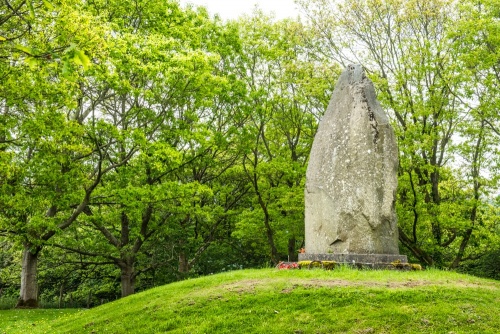
Something that must surely be relevant to our understanding of the stories, but which gets little comment, is the political scenario that was current when they took form and also when they were set down. By the time of the earlier manuscript, the White Book of Rhydderch, the four-hundred-year monarchy of Gwynedd had been destroyed by the English invaders under Edward I and Wales ‘conquered’. If the stories were actually fixed a century or two earlier (as suggested by Sir Ifor Williams), we know that relations at that time were somewhat better – Llewelyn the Great was married to Siwan (aka Joan), a daughter of the English King John, and a century or so earlier, the celebrated Nest ferch Rhys was mistress of Henry I. The range of plausible dates for the manuscript of the Red Book of Hergest covers the attempted war of liberation by Owain Glyndwr, and its failure. We simply do not know whether the stories were in their own time considered celebratory of Gwynedd, or the opposite. The stories appear in just the two manuscripts. One might imagine that if they were popular then more copies might have been made, so one must suspect that after Glyndwr was gone, the gentry preferred the more recent Anglicised ‘Arthur’ to the legends of their own land.
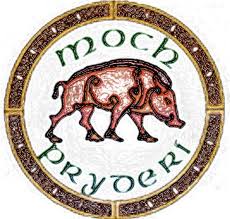
My own focus in this post is on a small part of the text, specifically the episode opening the Fourth Branch, usually known as ‘The Pigs of Pryderi’. My feeling is that most commentators largely ignore this story, treating it as of little significance in itself, (bearing ‘no apparent relation to the rest of the story’ according to the highly respected Patrick Ford introduction) and rather as just setting the scene – perhaps farcically – for the more dramatic business of Gwydion, Aranrhod, Lleu and Blodeu(w)edd. And yet, as often repeated, the continuity of the four branches is specifically that of the life of Pryderi, born in the first branch, warrior in the second, king in the third, and dying in the fourth.
My ‘problem’ is that the text just doesn’t make sense. Modern readers seem typically to slide over these issues, but I believe they would have been more apparent to any original audience. It’s not sufficient just to invoke ‘magic’ as the solution to them. Audiences are happy with Gwydion turning toadstools into gold – such events are surely essential to any good story – but other matters have to be consistent with the audience’s own knowledge and experience.
The story begins with Gwydion asking his uncle Math for permission to steal the pigs.This quote from the Gwyn Jones’ translation
“Lord,” said Gwydion [to Math son of Mathonwy],I have heard tell there have come to the South such creatures as never came to this Island.” “What is their name?” said he. “Hobeu, lord.” “What kind of animals are those?” “Small animals, their flesh better than the flesh of oxen. But they are small and they change names: moch are they called nowadays.” “To whom do they belong?” “To Pryderi son of Pwyll, to whom they were sent from Annwn [the Underworld], by Arawn king of Annwn.”
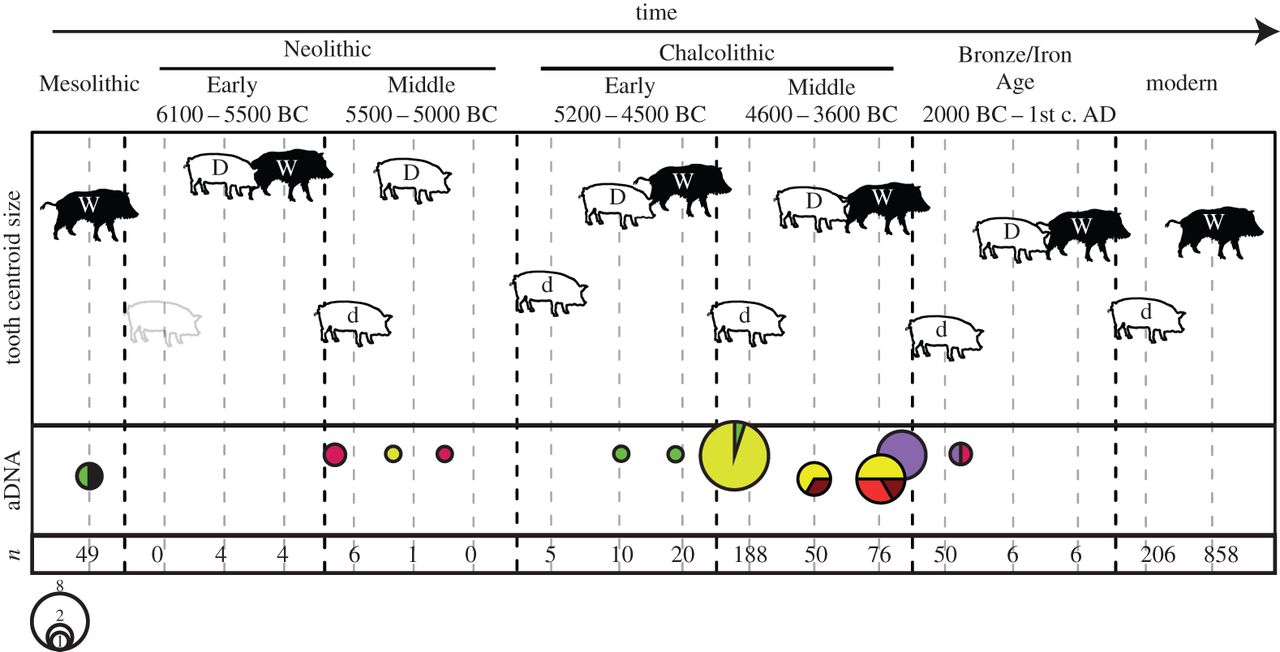
The first problem with the extract is that of historicity. Pigs were in no way introduced to Britain at the time when the stories are set – although somewhat vague, the most reasonable guess is to situate the tales at a point not long before the first Roman invasions. Pigs though, were first domesticated up to eleven thousand years ago, in the Tigris basin area. Marija Gimbutas suggests that the pig had become a sacred animal no later than 6000 bce. Pig culture spread westwards with Neolithic farming, and had certainly been in Britain for thousands of years before the Romans. In the past it was speculated whether a single strain was propagated as part of the ‘Neolithic package’ – but recent DNA-based research has demonstrated that pigs were ‘re-domesticated’ or ‘genetically improved from wild stock’ on multiple occasions. The Mabinogi audience did not have modern evidence to hand, but we have no reason to believe that the pig story was considered historically accurate.
Further then, is the idea that they came from Annwn. In the stories (the first branch) this is a physical place geographically contiguous with Dyfed. It can only be to the west or south-west, which makes it ‘Cantre Gwaelod’, now flooded by the sea. This land certainly did exist, and was lost not so far from the time of the stories’ setting (evidence suggests that the flooding had reached current shorelines by the second century ce ). Archaeology is difficult at the bottom of the sea. Still, there’s really no reason to believe that pigs were ever introduced to the rest of Britain from this area. Modern readers often consider ‘Annwn’ to be ‘The Otherworld’, something accessible via shamanic trance, and hence must treat Pwyll’s experiences in that way. This may work for us, but it’s not viable in the story. Some Victorian spiritualists allegedly managed to manifest a bit of ‘ectoplasm’, but I’ve never heard of even the most impressive of shamans manifesting real live pigs. It is, we may believe, possible for Deities to move physically between the worlds, and to bring material things with them. Such are usually termed ‘culture heroes’, found in the sacred stories of many peoples. Often they are Firebringers, such as Prometheus in Greece. In the traditions of North America, Skywoman falls to Earth in entirely physical form. But there is nothing else in the Mabinogi that would support interpretation on ‘culture hero’ lines.
Something further in this passage is deeply suspicious to my mind. Why is there the business of the name of the creatures? The sentence about the change of names is in quotes in both Jones and Ford translations, so should not be seen as an interpolation by a presumed narrator. The word ‘hobeu’ is apparently only ever used in the ‘White Book’ and ‘Red Book’ manuscripts. Modern Welsh always uses ‘moch’. Wikipedia has a page for a ‘Celtic boar/pig/swine god’ named ‘Moccus’, equated with Mercury (as Gwydion might well also be), surely proving pigs as well -established in the culture. Archaic / dialect English uses the word ‘hob’ for the ferret – a creature rather different from a pig. My feeling about this is that ‘hobeu’ vs. ‘moch’ is a play upon words, a pun, that is, something intended as a joke. Sadly the joke is wholly lost on us moderns, but one has to presume that the audience would have found it funny in some way. A little research in my (obviously inadequate) Pocket Welsh Dictionary just conceivably indicates a multilingual pun, not necessarily impossible at the time of the scribe – the word ‘hobaid’ is translated as (feminine noun) ‘peck’, but the English verb ‘to peck’ is translated as ‘pigo’. My only guess at the ‘joke’ then, is that it makes an equivalence of (hen)peckers and pigs, the misogyny of which indeed anticipates my larger theme.
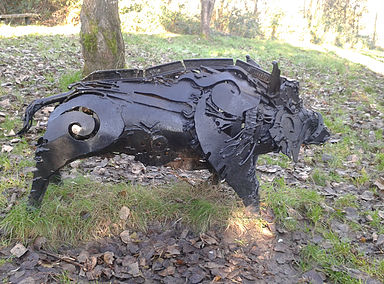
Moving on, when Gwydion asks Pryderi for the pigs, Pryderi replies:
“there is a covenant between me and my country concerning them; that is, that they shall not go from me till they have bred double their number in the land”
This ‘covenant’ is also interpreted as a ‘geis’, a sacred vow that is often also ‘doomed’. But it is surely somewhat strange – pigs are well-known as bearing numerous piglets in each litter; so if adequately fed, and not eaten, it would not take very long for their numbers to double. How could it be such a significant matter for Pryderi?
Once Gwydion has actually abducted the pigs the story becomes truly absurd. One suspects that academic commentators are not very familiar with the behaviour of real live pigs. We are asked to believe that a bunch of twelve men, who have never before set eyes upon these creatures, let alone handled them in practice, are able to drive them from Rhuddlan Teifi (near Lampeter) to Creuwyron (just outside modern Bangor). But actual pigs are not at all happy to be driven more than a short distance, often needing a little training for that. They can balk at almost anything (including puddles); they may bunch together too tightly to move easily, or of course, try to make a run for it. One would guess, since the number appears repeatedly in other contexts, that there were twelve pigs taken. We might presume that the pigs would be distressed at being roused and chivvied by strangers. Gwydion tells his men to move quickly, since he expects pursuit by horsemen once the his illusion spell wears off. Any attempt at some secretive route would surely delay their progress, but in any case, the trail left by a dozen men, presumably their dozen horses, and a dozen pigs would be as wide as a modern motorway – just the pigs’ droppings would be ample for the most incompetent of pursuers to follow.
The story tells us that the first day of the journey takes them to Mochdref (pig-town, near modern Machynlleth). I challenge anyone to do this in reality, (it would be an extreme hike for the most vigorous of unencumbered walkers) nor are the subsequent journeys feasible. Gwydion would indeed have had to sprout magic wings for the pigs, plus golden harness of course. (We think flying pigs are fun, but you can’t put them in a story meant seriously.) The route takes them around the mountains so as to reach Bangor after but four overnight stops. Much is made of repeated onomastica (explanation of place names) – too much surely. One feels that a storyteller, singing for his supper using this stuff, might go hungry. At Creuwyron the pigs are then put into a sty, and nothing more is told of them whatsoever.
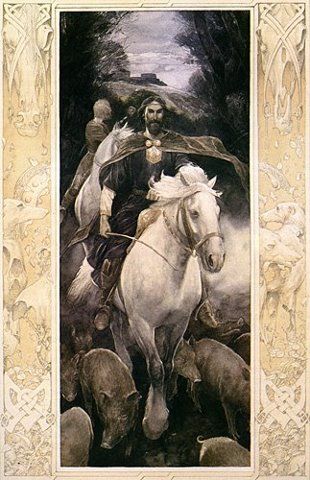
Bizarrely, when Gwydion reaches nearby Caer Dathyl, even though it is understood that he had been driving animals, he is told “Strange how very slowly you have journeyed!”. The lord of Gwynedd is already making preparations for war, with Pryderi raising twenty-one cantrefs against him (at least three times the Gwynedd population). One presumes that Pryderi had the politeness to have sent heralds in ultimatum, rather than make war unannounced. At this point one can wonder as to the scale of the war. It was not so uncommon for Celtic tribes to indulge in a bit of stock-rustling. Yet Pryderi raises his entire land, at maximum urgency, for just a few pigs.
The story continues to describe fierce battle – with phrases such as ‘great slaughter on either hand’ and the final single combat between Pryderi and Gwydion, in which, “by magic and enchantment Gwydion conquered and Pryderi was slain”.
The standard story is as loathsome as one could wish, since the only point of this war is apparently to get Math, lord of Gwynedd, into war mode, so as to facilitate the rape of Math’s “footholder”, the maiden Goewyn, by Gwydion’s brother Gilvaethwy. In my view, Goewyn is about the only character in the standard story to emerge with any credit. Far from being intimidated by these men (Gwydion is presumed to be the heir to the Gwynedd throne), at first opportunity she calls out the rapist(s) saying:
“Assault was made upon me, and that openly. Nor did I bear it in quiet…They wrought rape upon me and upon thee dishonour”
Note that she says ‘they’, implying Gwydion as rapist as well as panderer, and that it is Math who is dishonoured, not herself.
Rereading the story recently, I find a couple further suspicious sentences, ignored by commentators I believe. Before the final fight, Pryderi gives hostages against the truce. But this practice did not happen in such warfare, or at least not one-sidedly, unless an army were fully defeated. It is said that ‘Gwrgi Gwastra’ is one of the hostages. It is subsequently implied, when hostages are released, that Gwrgi is the ‘lord’. Presumably then, he was heir to Dyfed and now rightfully its king. Most writers therefore assume him to be Pryderi’s son. The problem is that ‘Gwrgi Gwastra’ is not plausible as a real name for a king’s son. ‘Gwrgi’ can mean something on the lines of ‘cannibal’, linked to an Irish word for ‘werewolf’. ‘Gwastra’ means ‘vain’. Other Gwrgi persons in literature include ‘Gwrgi Garwlwyd’ (man-dog rough-grey) – a mass-murdering warrior. The word is obviously the same as the modern ‘corgi’ dog, mostly thought somewhat laughable, even if royally appreciated. Originally though, a ‘cur’ dog was the lowest sort of ankle-biting cattle-driving beast – the word ‘ci’ just means ‘dog’ in general. (There are ‘name issues’ with the whole family, including those of Cigfa and Pryderi himself, but these must wait for another day.)
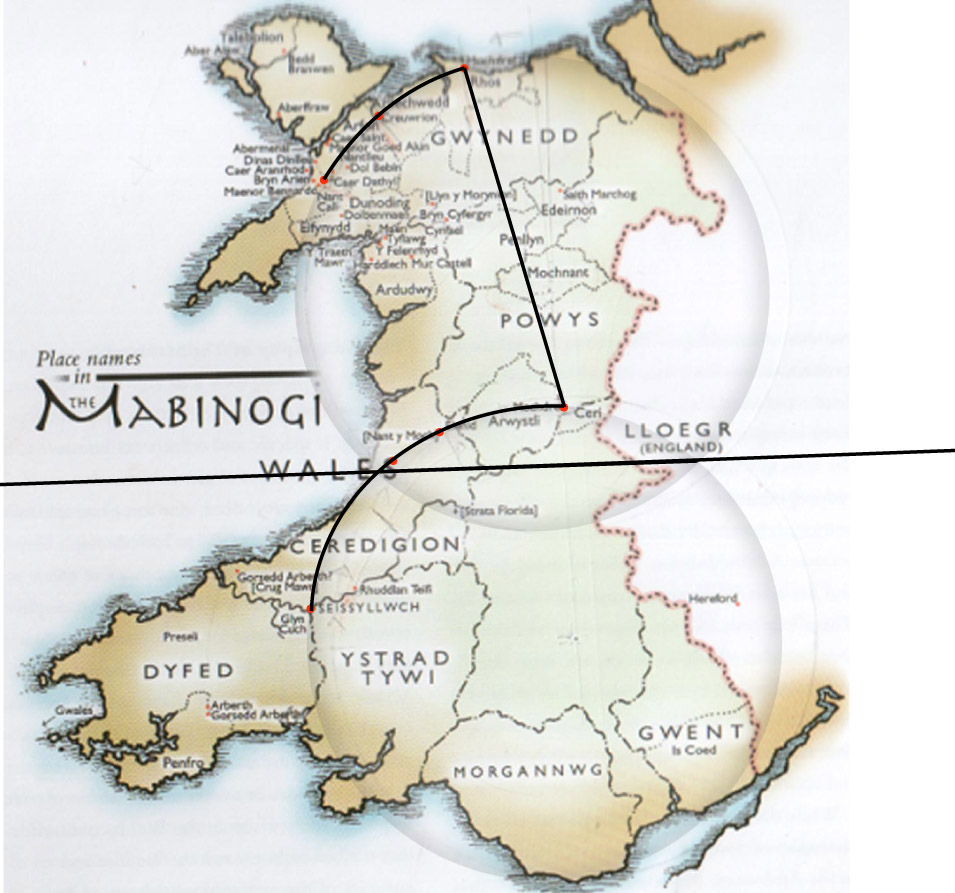
What on earth is to be made of all this? Whether the audience were peasants or gentry, they could in no way credit the ‘pigs’ as the creatures they knew by that name. If not ‘real pigs’ can they be ‘symbolic’ of something? If the Mabinogi were “Pilgrim’s Progress” we could guess that the pigs were ‘symbolic’ of ‘lust’ and ‘greed’. But there is no reason to interpret the rest of the stories in such a manner, not has it been seriously suggested. A plausible alternative to that sort of pious allegory, one consistent with what we know of Celtic culture, is that the stories as we know them actually constitute a sort of ‘satire’. Sadly, we have no trace whatsoever of earlier versions of the stories, but clearly my hypothesis requires prior versions to have existed and to have been well-known. Satire only works if the audience are familiar with what is being satirised, and also with the import of the mode of satire. To take a modern example, the ‘Donald Trump blimp’, depicting him as a baby in a nappy, would just not work if we were not well acquainted with his image, and did not think of him as an overweight infantile narcissist.
Satire is not an unreasonable interpretation. Pryderi is, quite simply, the son of a Goddess. His Mother, Rhiannon, is considered to be a ‘reflex’ of the Gaulish ‘Rigantona’ – Great Queen, and further more or less equivalent to the Irish ‘Mor Rigan’ (also ‘Great Queen’) and to the ‘Horse Goddess’ known to Roman soldiers as ‘Epona’. One might expect therefore that if the stories had any connection to Pagan spirituality, then Pryderi, appearing in all four branches of the Mabinogi, would get favourable report. But in the texts we have, and also as implied in most modern commentary, he is treated as something of an idiot. The first three branches are bad enough, whilst in the fourth he is so stupid as (a) to be seduced of his magic pigs (b) to start a serious war over them and finally (c) to get himself killed.
My personal feeling, reinforced by the insult to Pryderi’s son, described above, is that ‘satire’ is too kind a term by far. Rather, the Mabinogi (or at least, those parts referring to Pryderi) are actually a sustained insult, a blasphemy in fact, to the Pagan Deities. I don’t claim this view as original; for example, in his novel ‘Porius’, John Cowper Powys seems to feel likewise, at least as regards to Pryderi. But it seems to me that such a hypothesis requires some attempt at alternative explanation and reconstruction of ‘the real story’. Indeed, we really need at least two levels of prior story – one in which the characters are truly Goddesses and Gods (perhaps not so ‘dramatic’), and a second in which they are more humanised, but retain proper dignity. Given that we have no actual evidence whatsoever, few modern writers risk anything in this direction. But having no academic reputation at stake, I shall leap into this bog, hoping to land safely on a kindly rock just below water level.
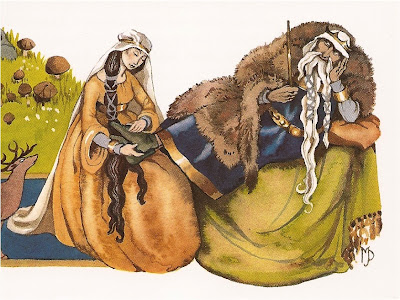
To start with then, the ‘pigs’ are really women. Not just any women but actually the primary college of priestesses of Dyfed. As such, they undoubtedly constitute the Sovereignty of the Land, much described by Matthews and others. My own (hopelessly un-academic) reconstruction above of the hobeu / moch ‘joke’ hints at reference to women. As women, they are a sensible fit to the ‘double their number’ geis. This simply means that they were pledged to raise a daughter to succeed them before retiring from their role. Their being ‘from Annwn’ connects them to the ‘Old Religion’ (something more matriarchal at least) and / or to chthonic Earth spirituality. Actual women could be tied to horseback and moved at comparative speed from Lampeter to Bangor, and would leave rather less trail than pigs.
The abduction, and we may surely presume, the rape, of these women, would have constituted a fundamental spiritual and political assault upon the land of Dyfed. The Romans’ rape of Boudicca’s daughters may be seen in the same light, and was just as unforgiveable – once war was commenced, Boudicca did not stop until she and her army were defeated and slaughtered. It was thus entirely proper for Pryderi immediately to raise the maximum force of war in attempting the rescue and defence of the Holy Women. It is of course sad that Pryderi failed in that final battle against the rapist Gwydion, but we may reinstate Pryderi to proper honour. Not a pathetic idiot, but rather a true Son of the Goddess, dying in unflagging defence of Her honour, as manifested in Her Holy Women. Kenneth Morris suggests that after death Pryderi will have apotheosis, joining the Immortals. Quite rightly!
I have wondered whether the ‘pig’ theme is just the storytelling trick of the final redactor, or something more. If everyone knew the ‘true story’, but had no sympathy for it (being Christians) then perhaps it was enough just to tell the story in the form we have. But I am suspicious that the idea of referring to women (or especially, to priestesses) as ‘pigs’ was more than just the redactor’s personal misogyny. I have to go back a long way to get any connection here.
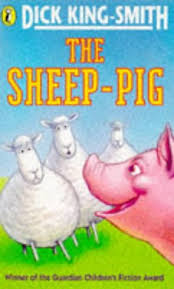
In our present-day culture, pigs do not have good PR. This is quite unfair. Left to themselves they are as clean as any creature – we humans would surely soon be quite pongy if forced to live in a sty with no washing or sanitation facilities. Pigs are actually quite intelligent – the writer Dick King-Smith (author of ‘The Sheep -Pig’, filmed as ‘Babe’) considered them at least as clever as dogs. Pigs are metabolically more like humans than most creatures, and it has been possible to transplant bits of pig into humans. Why should we despise them so intensely? (We are much kinder to other creatures that are eaten.) The reason has to be the dreadful combination of religion and politics. Rationalisation based on public health concerns is quite spurious.
My suggestion is that the piggist propaganda actually dates back quite a few thousand years, to the point when the Indo-European folk began to move from their Ukrainian homelands into Europe. My thoughts on this have been greatly stimulated by the work of Maria Kvilhaug, for example: http://freya.theladyofthelabyrinth.com/?page_id=761. There has been much controversy about all this, but my understanding is that modern DNA research has largely confirmed the earlier language-based migration theory, despite the continued opposition of many archaeologists. Seems to me that Marija Gimbutas’ work has been confirmed more than refuted, though I feel there is no need to accept all of her interpretations.
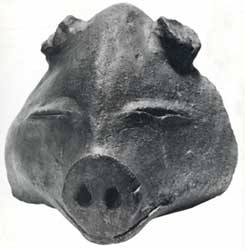
The Indo-Europeans did not keep pigs. Theirs was a culture based on the herding of horses and cattle. But their first major cultural encounter on migration westward was with the people of ‘Old Europe’, who were settled farmers, and certainly pig-keepers. So as the Indo-Europeans became dominant, I suggest simply that they used the sort of dehumanising language all too common with modern day warmongers and oppressors, so that the conquered became ‘pig-people’. or pigs, for short. I would postulate that something similar happened in the Levant, when the Semitic tribes (Hebrews and Arabs) moved into Canaan. The Semites were herders of sheep and goats, again encountering settled farmers with pigs. Most of our modern-day piggist prejudice derives from them and their ‘holy books’.
I think there may be something further. It is not unreasonable to suggest a ‘Pig Goddess’ in Old Europe. Kvilhaug suggests that the historical basis of the Vanir (as opposed to the Indo-European Aesir) is in fact the people, and/or deities, of Old Europe. In the extant Norse sources there are indeed ‘Pig deities’, namely the Vanir siblings Freyr and Freyja. (At the least, both ride on magical pigs.) So it seems to me that it becomes painfully easy to imagine that the priestesses and priests of these deities might be referred to, by Indo-European (or Semitic) misogynists, simply as ‘Pigs’. I suspect that this unpleasantness was as sticky as pig-poo, and that patriarchs and misogynists have had a long-standing ‘tradition’ of referring to spiritual women as pigs. This has barely disappeared – legends about pig-faced women were around as late as the 19th century and a 2006 film, ‘Penelope’ starring Christina Ricci had this theme. The phrase ‘pig in a poke’ was in the past applied to women in bonnets – it is still in use.
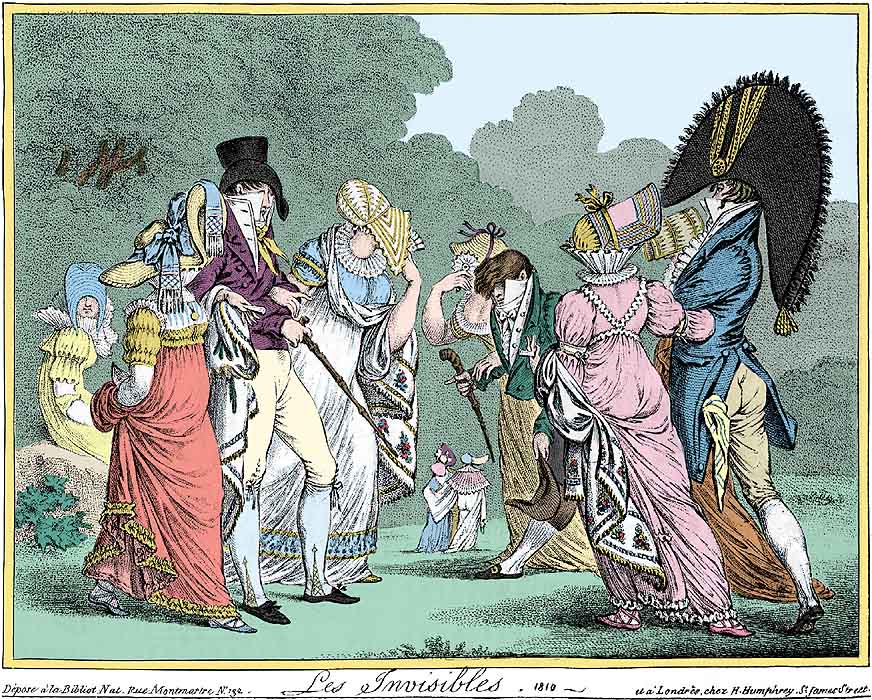
The challenge remains to reconstruct some of the story, at one or both of the prior levels I suggest. I would have been as wary of doing this as better scholars seem to be. However, after speaking about the above ideas recently to a Pagan group I found a story flooding into my consciousness, and had to write it down in order to be able to think of anything else. Whether this constituted ‘authentic spiritual vision’, or otherwise, you may judge for yourselves.
I’ve put the story on a separate page linked below. Here are a few notes about it in advance. If you want to discuss it (politely) with me, I would appreciate your thoughts. My story does of course resolve the sundry issues in the standard form. I found little use for Gilvaethwy except as a liar. Didn’t seem any need for two rape scenes (especially if the story was originally transmitted pictorially) so Goewyn has relocated to Dyfed. ‘Gwrgi’ must surely bear the true name of ‘Gwri’ (his father’s child-name), though the best I can do for a pun-original for ‘Gwastra’ is the modern Welsh ‘gwastad’ which can mean ‘constant’ or ‘steadfast’ as well as ‘level’ etc; I give him that character. Because the standard text does not mention the pigs’ release, which for me is vital, I have perhaps fudged some locations a little closer together than they actually are on the ground. (You can find actual maps for sites mentioned here: http://www.nantlle.com/mabinogi-saesneg-places-mentioned-in-the-fourth-branch.htm) The end of my story has no literary source, but it was as insistent as the rest. It still leaves enough timeframe for the doings of Aranrhod / Lleu / Blodeu(w)edd, and indeed it explains why the standard fourth branch text tells of Lleu becoming lord of Gwynedd, but not Gwydion. You may spot the rest of my not-very-subtle allusions for yourselves.
I do have a worry about all this… If my hypothesis is correct – that the entire fourth branch of the Mabinogi (at the minimum) is actually an insult and a blasphemy – then it must be plausible that Gwydion is being traduced no less than Pryderi and his family are being insulted. The most obvious deity corresponding to Gwydion (via no more than the standard Welsh mutation) is the Germanic Woden (like Moccus, equated to Mercury by Romans). Tales of Woden / Odin certainly do have Him as a master of deceit and as a warmonger – rape only occurs once in a strange prophecy-fulfilling tale. But still, I feel Odin’s true nature to be something well beyond human nastiness. I can but await Gwydion telling his side of the tale!
My own telling of the tale of The Pigs of Pryderi is here:
https://pandorasjar.org/the-pigs-of-pryderi